Search Result
Results for "
cereblon E3 ubiquitin ligase
" in MedChemExpress (MCE) Product Catalog:
2
Isotope-Labeled Compounds
| Cat. No. |
Product Name |
Target |
Research Areas |
Chemical Structure |
-
- HY-143715
-
|
|
Ligands for E3 Ligase
|
Cancer
|
|
Cereblon inhibitor 1, an isoindoline derivative, is a cereblon E3 ubiquitin ligase modulating agent. Cereblon inhibitor 1 has the potential for cancer research.
|
-
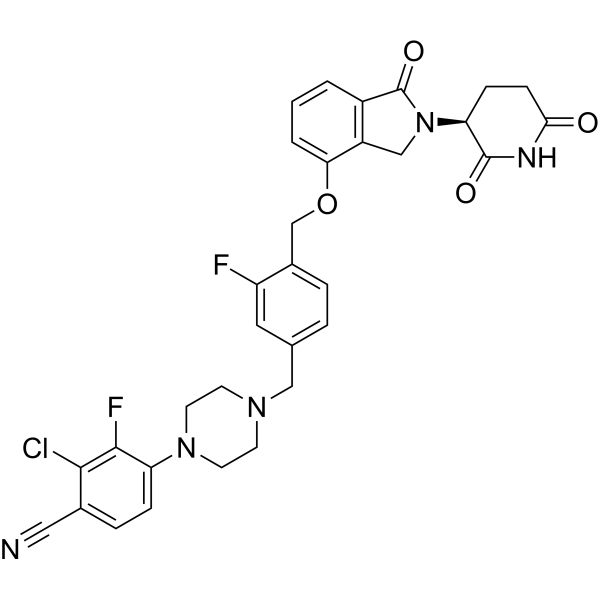
-
- HY-43722
-
|
|
Ligands for E3 Ligase
|
Cancer
|
|
Lenalidomide-Br (Compound 41) is an analog of cereblon (CRBN) ligand Lenalidomide for E3 ubiquitin ligase, and is used in the recruitment of CRBN protein. Lenalidomide-Br can be connected to the ligand for protein by a linker to form PROTACs, such as the PROTAC STAT3 degrader SD-36 (HY-129602) .
|
-
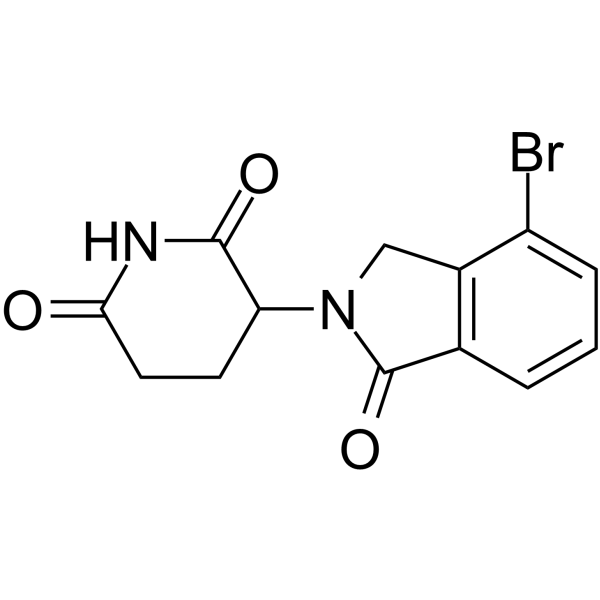
-
- HY-153357
-
|
|
Btk
|
Cancer
|
|
NRX-0492 is an orally active and potent degrader of BTK. NRX-0492 catalyzes ubiquitylation and proteasomal degradation of BTK with DC50≤0.2 nM and DC90≤0.5 nM, respectively. NRX-0492 inhibits B-cell receptor (BCR)-mediated signaling, transcriptional programs, and chemokine secretion. Moreover, NRX-0492 also links a noncovalent BTK-binding domain to Cereblon. Cereblon is an adaptor protein of the E3 ubiquitin ligase complex .
|
-
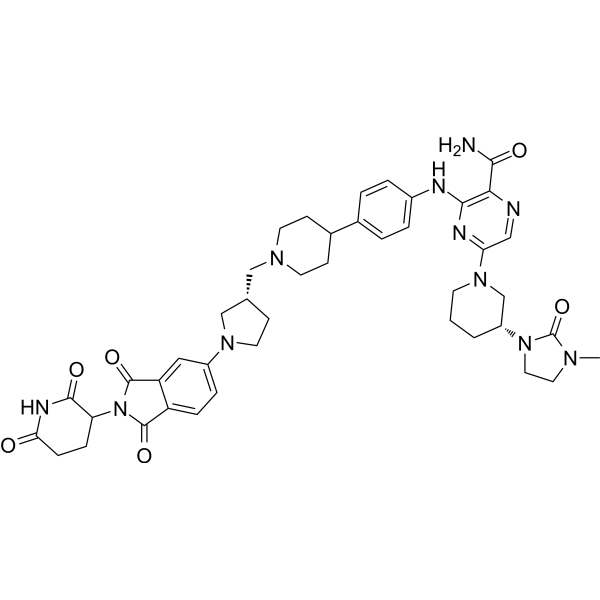
-
- HY-W145436
-
-
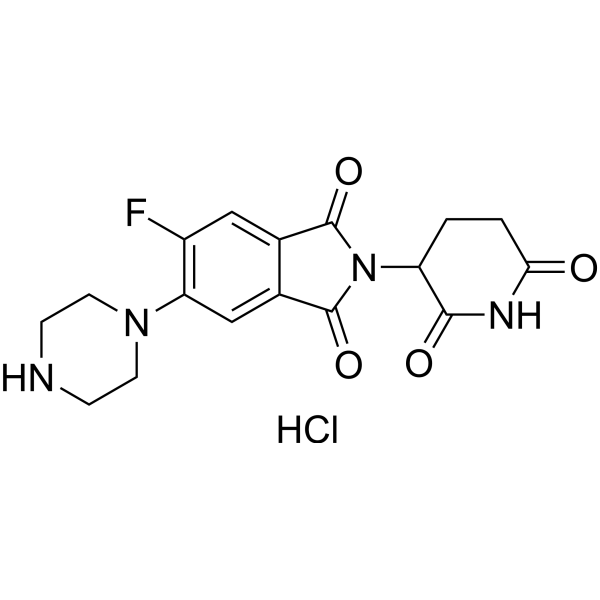
-
- HY-144980
-
|
|
Ligands for E3 Ligase
|
Cancer
|
|
E3 ligase Ligand 21 (compound 2) is a cereblon binder for the degradation of Ikaros or Aiolos by the ubiquitin proteasome pathway .
|
-
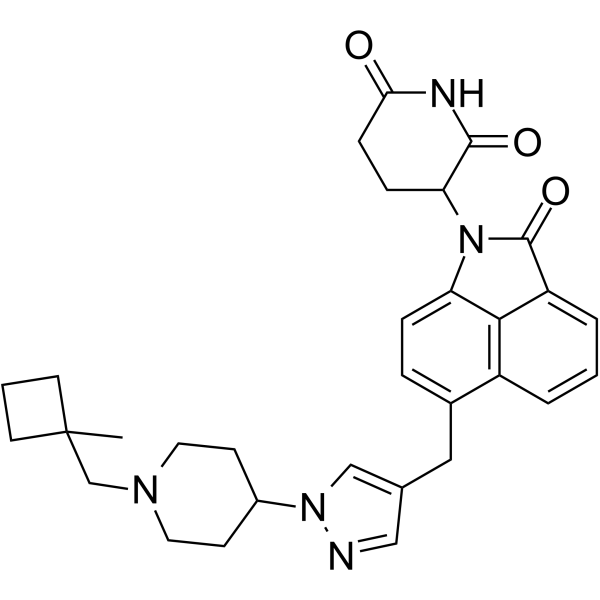
-
- HY-144983
-
|
|
Ligands for E3 Ligase
|
Cancer
|
|
E3 ligase Ligand 22 (compound 139) is a cereblon binder for the degradation of Ikaros or Aiolos by the ubiquitin proteasome pathway .
|
-
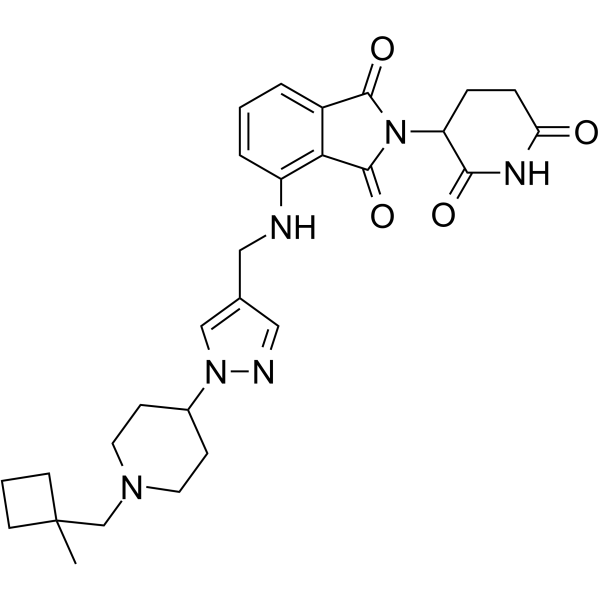
-
- HY-144985
-
|
|
Ligands for E3 Ligase
|
Cancer
|
|
E3 ligase Ligand 23 (compound 17-6) is a cereblon binder for the degradation of Ikaros or Aiolos by the ubiquitin proteasome pathway .
|
-
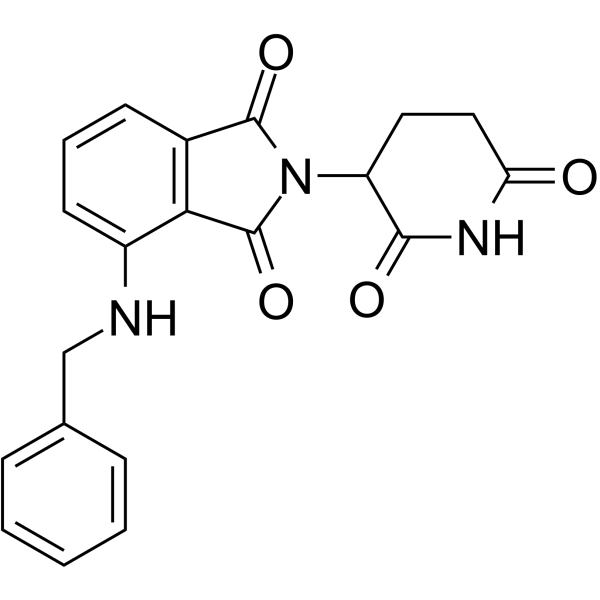
-
- HY-132288
-
|
|
E3 Ligase Ligand-Linker Conjugates
|
Cancer
|
|
Pom-8PEG, an E3 ligase ligand-linker conjugate, incorporates a cereblon (CRBN) ligand for the E3 ubiquitin ligase and an 8-unit PEG linker. Pom-8PEG can be used in the synthesis of PROTAC, such as IDO1 PROTAC degrader .
|
-
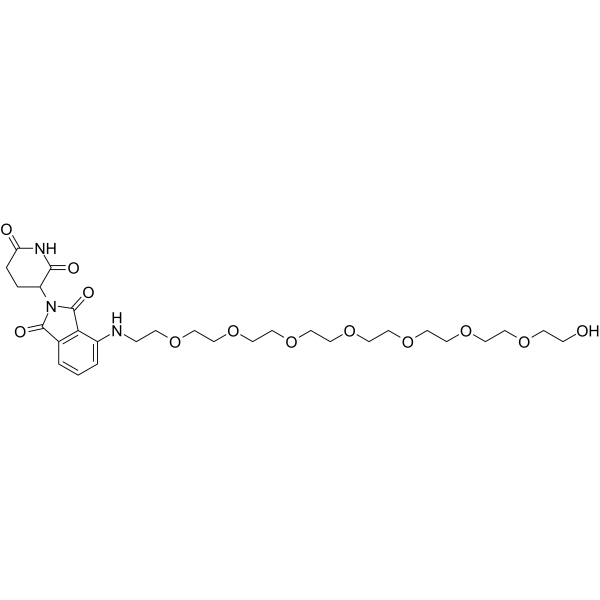
-
- HY-129395
-
|
CC-92480
|
E1/E2/E3 Enzyme
Molecular Glues
Apoptosis
|
Cancer
|
|
Mezigdomide (CC-92480), a cereblon E3 ubiquitin ligase modulating agent (CELMoD), acts as a molecular glue. Mezigdomide shows high affinity to cereblon, resulting in potent antimyeloma activity .
|
-

-
- HY-131863
-
|
|
Ligands for E3 Ligase
Apoptosis
Molecular Glues
|
Cancer
|
|
Pomalidomide 4'-alkylC8-acid is an E3 ubiquitin ligase ligand-Linker conjugate containing Pomalidomide (HY-10984). Pomalidomide is a third-generation immunomodulator that acts like a molecular glue. Pomalidomide interacts with the E3 ligase cereblon to induce degradation of the essential Ikaros transcription factor .
|
-
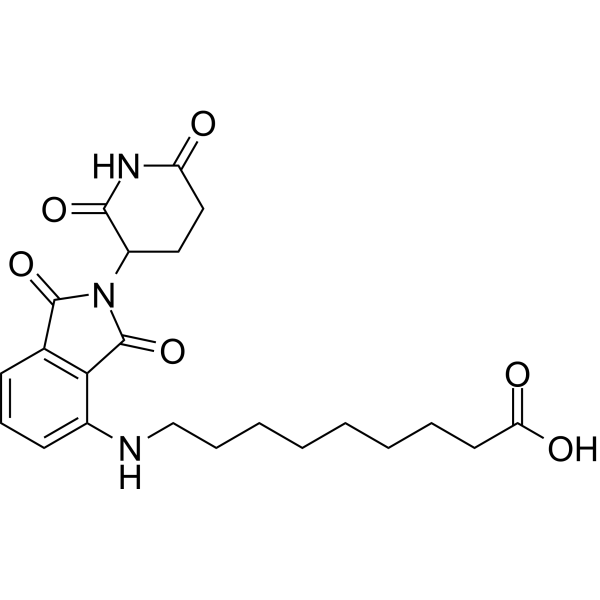
-
- HY-139336
-
-

-
- HY-123937
-
|
|
PROTACs
CDK
|
Cancer
|
|
THAL-SNS-032 is a selective CDK9 degrader PROTAC consisting of a CDK-binding SNS-032 ligand linked to a thalidomide derivative that binds the E3 ubiquitin ligase Cereblon (CRBN) .
|
-

-
- HY-133144
-
|
|
Ligands for E3 Ligase
|
Cancer
|
|
Lenalidomide-OH is an analog of cereblon (CRBN) ligand Lenalidomide for E3 ubiquitin ligase, and is used in the recruitment of CRBN protein. Lenalidomide-OH can be connected to the ligand for protein by a linker to form PROTACs, such as the PROTAC BTK degrader SJF620 (HY-133137) .
|
-
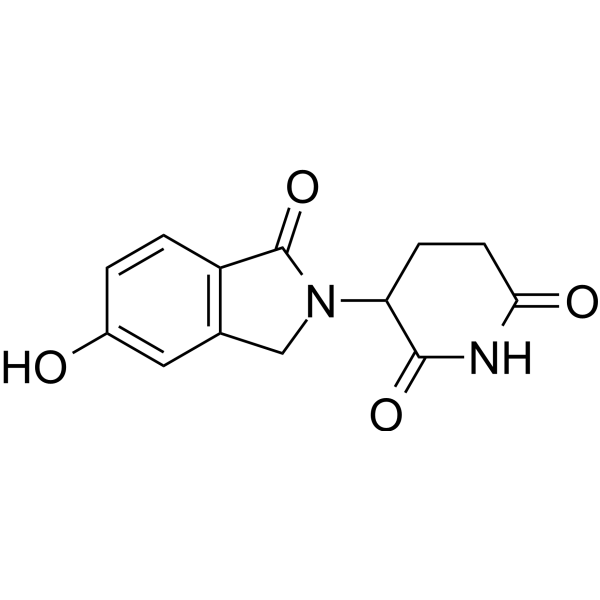
-
- HY-153220A
-
|
|
Btk
|
Inflammation/Immunology
Cancer
|
|
(R)-NX-2127 (compound 28) is an orally active Bruton’s Tyrosine Kinase (Btk) degrader. (R)-NX-2127 degrades IKZF1 and IKZF3 by molecular glue interactions with the cereblon E3 ubiquitin ligase complex .
|
-

-
- HY-136160
-
|
|
E3 Ligase Ligand-Linker Conjugates
Autophagy
Apoptosis
|
Cancer
|
|
Thalidomide 4'-oxyacetamide-alkyl-C2-amine hydrochloride incorporates a cereblon (CRBN) ligand for the E3 ubiquitin ligase, and a linker. Thalidomide 4'-oxyacetamide-alkyl-C2-amine hydrochloride can be used to design the PROTACs .
|
-
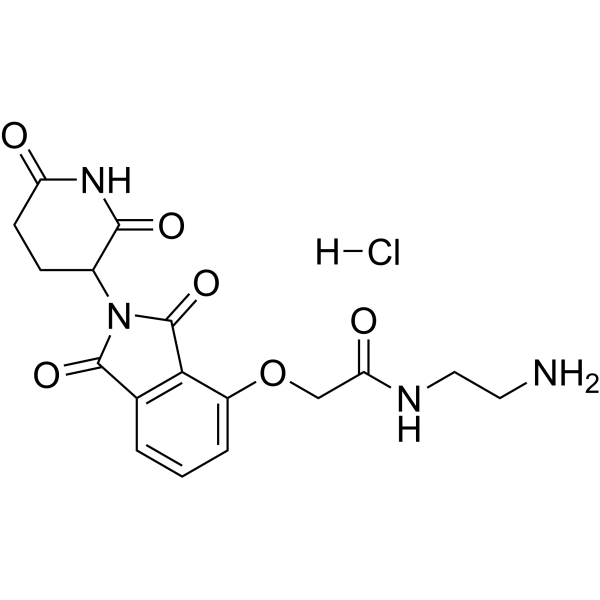
-
- HY-131318
-
|
|
Ligands for E3 Ligase
|
Cancer
|
|
Lenalidomide-I (Compound 72), an analog of cereblon (CRBN) ligand Lenalidomide for E3 ubiquitin ligase, is used in the recruitment of CRBN protein. Lenalidomide-I can be connected to the ligand for protein by a linker to form PROTACs, such as the PROTAC BET degrader QCA570 (HY-112609) .
|
-

-
- HY-130835
-
|
RC32
|
PROTACs
FKBP
|
Cancer
|
|
FKBP12 PROTAC RC32 (RC32) is a potent FKBP12 degrader based on PROTAC technology. FKBP12 PROTAC RC32 contains conjugation of Rapamycin (HY-10219) and a ligand for an Cereblon E3 ubiquitin ligase (Pomalidomide; HY-10984) .
|
-

-
- HY-157510
-
|
|
E3 Ligase Ligand-Linker Conjugates
|
Cancer
|
|
Thalidomide-O-C3-azide is a click chemistry modification of the cereblon (CRBN) inhibitor Thalidomide (HY-14658). Thalidomide-O-C3-azide contains an azide group and can undergo copper-catalyzed azide-alkyne cycloaddition reaction (CuAAc) with molecules containing alkyne groups. Thalidomide-O-C3-azide can be used as a ligand of E3 ubiquitin ligase and Linker conjugates (E3 Ligase Ligand-Linker Conjugates) for the synthesis of PROTACs .
|
-
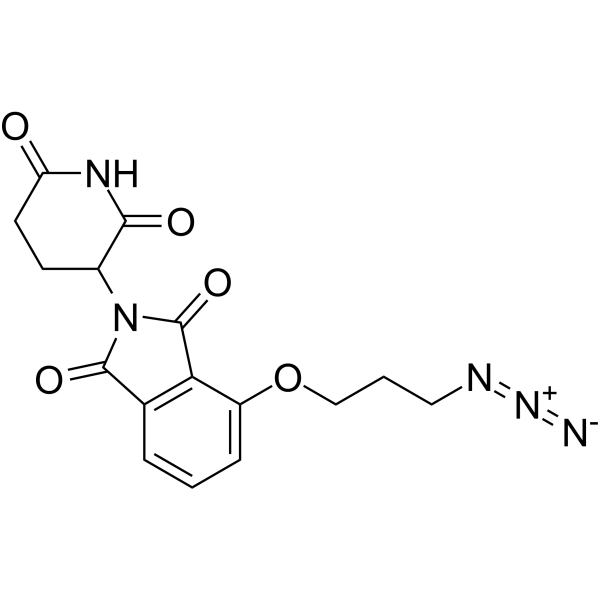
-
- HY-157511
-
|
|
E3 Ligase Ligand-Linker Conjugates
|
Cancer
|
|
Thalidomide-O-C5-azide is a click chemistry modification of the cereblon (CRBN) inhibitor Thalidomide (HY-14658). Thalidomide-O-C5-azide contains an azide group and can undergo copper-catalyzed azide-alkyne cycloaddition reaction (CuAAc) with molecules containing alkyne groups. Thalidomide-O-C5-azide can be used as a ligand of E3 ubiquitin ligase and Linker conjugates (E3 Ligase Ligand-Linker Conjugates) for the synthesis of PROTACs .
|
-
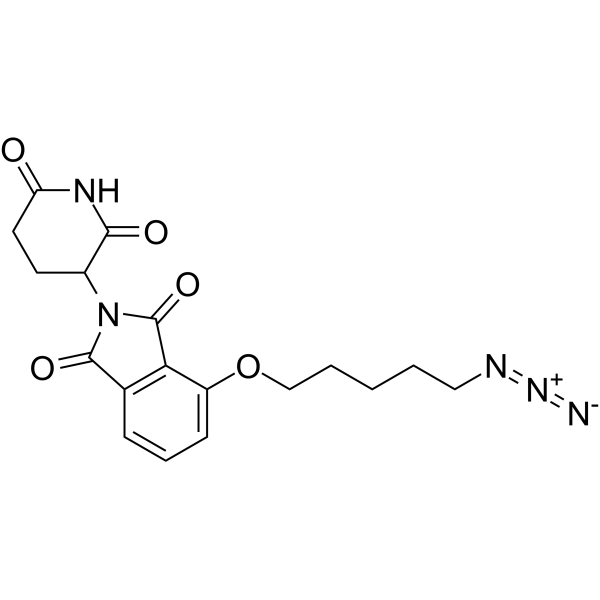
-
- HY-157515
-
|
|
E3 Ligase Ligand-Linker Conjugates
|
Cancer
|
|
Thalidomide 4'-ether-PEG2-azide is a click chemistry modified cereblon (CRBN) inhibitor Thalidomide (HY-14658). Thalidomide 4'-ether-PEG2-azide contains an azide group and can undergo copper-catalyzed azide-alkyne cycloaddition reaction (CuAAc) with molecules containing alkynyl groups. Thalidomide 4'-ether-PEG2-azide can be used as a ligand of E3 ubiquitin ligase and Linker conjugates (E3 Ligase Ligand-Linker Conjugates) for the synthesis of PROTACs .
|
-

-
- HY-155269
-
|
|
Ligands for E3 Ligase
|
Cancer
|
|
Pomalidomide-5-C13-NH2 hydrochloride is a Pomalidomide (HY-10984)-based E3 ubiquitin ligase cereblon (CRBN) ligand for recruiting cereblon proteins. Pomalidomide-5-C13-NH2 hydrochloride can be connected to protein ligands through a linker to form PROTAC.
|
-

-
- HY-112811
-
|
|
PROTACs
CDK
|
Cancer
|
|
PROTAC CDK9 degrader-2 (compound 11c) is a potent and selective CDK9 degrader based on PROTAC, with an IC50 of 17 μM in MCF-7 cell lines. Natural product Wogonin (CDK ligand) binds ubiquitin E3 ligase Cereblon (CRBN) via a linker to form PROTAC .
|
-
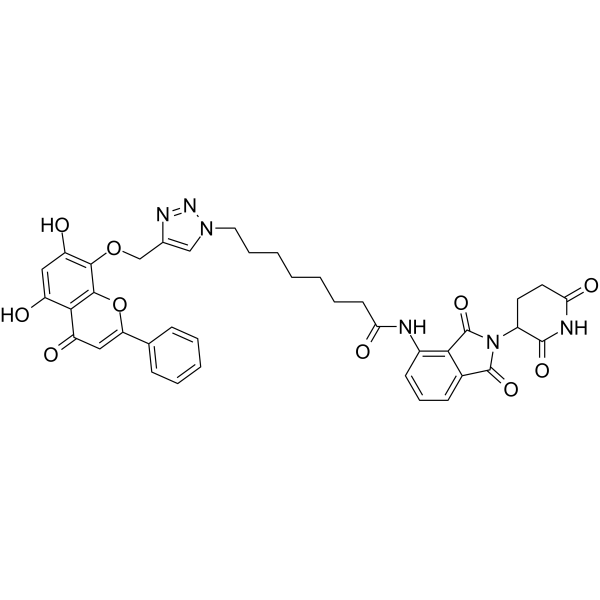
-
- HY-123844
-
dBET57
2 Publications Verification
|
PROTACs
Epigenetic Reader Domain
|
Cancer
|
|
dBET57 is a potent and selective degrader of BRD4BD1 based on the PROTAC technology. dBET57 mediates recruitment to the CRL4 Cereblon E3 ubiquitin ligase, with a DC50/5h of 500 nM for BRD4BD1, and is inactive on BRD4BD2 .
|
-

-
- HY-14658
-
-
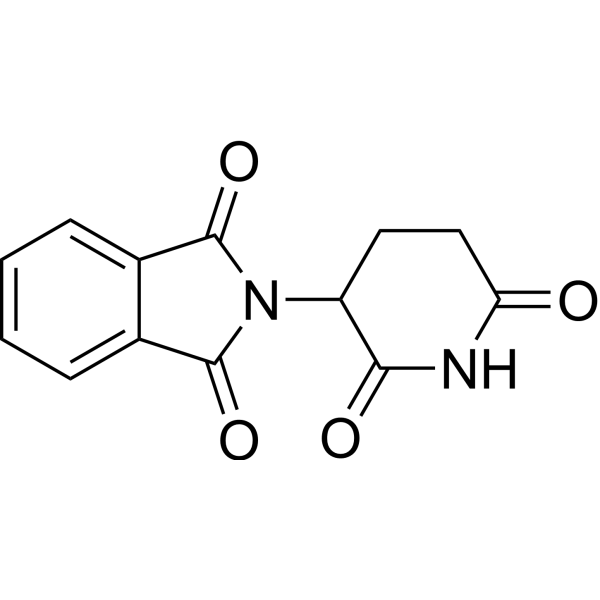
-
- HY-163210
-
|
|
Ligands for E3 Ligase
|
Cancer
|
|
Pomalidomide 5'-fluoro-6'-piperazine-4-methylpiperidine hydrochloride (ZJT1) is an E3 ubiquitin ligase cereblon based on Pomalidomide (HY-10984) (CRBN) ligand for recruitment of cereblon protein. Pomalidomide 5'-fluoro-6'-piperazine-4-methylpiperidine hydrochloride can be linked to protein ligand by linker to form PROTAC .
|
-

-
- HY-14658S
-
-
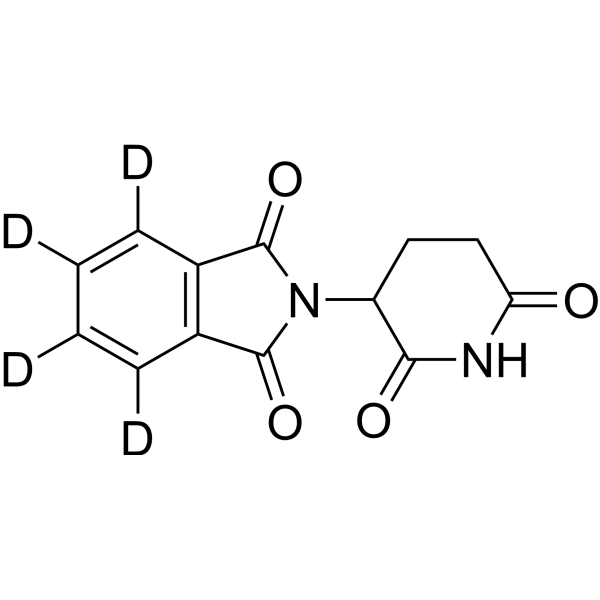
-
- HY-W877989
-
|
|
Ligands for E3 Ligase
|
Cancer
|
|
BWA-522 intermediate-1 is an intermediate in the synthesis of PROTAC BWA-522 (HY-149433) and serves as a ligand molecule for cereblon E3 ubiquitin ligase. BWA-522 is an orally active small molecule protein-targeting chimera (PROTAC) that has significant degradation effects on AR-FL and AR-V7 .
|
-

-
- HY-A0003
-
Lenalidomide
Maximum Cited Publications
32 Publications Verification
CC-5013
|
Ligands for E3 Ligase
Molecular Glues
Apoptosis
|
Inflammation/Immunology
Cancer
|
|
Lenalidomide (CC-5013), a derivative of Thalidomide, acts as molecular glue. Lenalidomide is an orally active immunomodulator. Lenalidomide (CC-5013) is a ligand of ubiquitin E3 ligase cereblon (CRBN), and it causes selective ubiquitination and degradation of two lymphoid transcription factors, IKZF1 and IKZF3, by the CRBN-CRL4 ubiquitin ligase. Lenalidomide (CC-5013) specifically inhibits growth of mature B-cell lymphomas, including multiple myeloma, and induces IL-2 release from T cells .
|
-
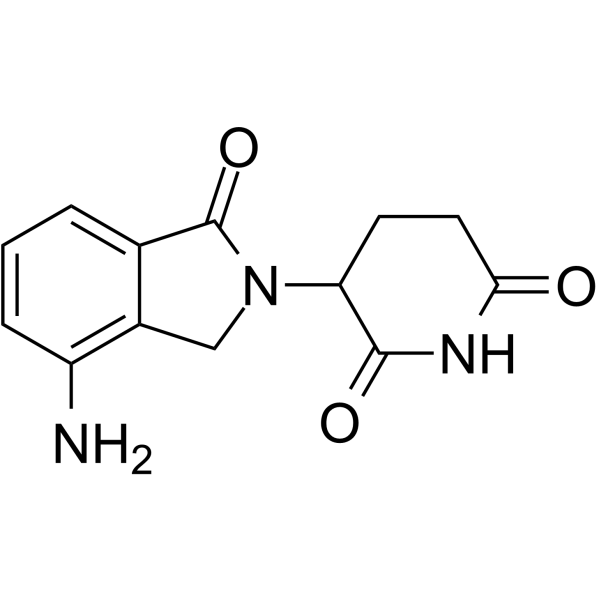
-
- HY-A0003B
-
|
CC-5013 hemihydrate
|
Ligands for E3 Ligase
Molecular Glues
Apoptosis
|
Cancer
|
|
Lenalidomide hemihydrate (CC-5013 hemihydrate), a derivative of Thalidomide, acts as molecular glue. Lenalidomide hemihydrate is an orally active immunomodulator. Lenalidomide hemihydrate (CC-5013 hemihydrate) is a ligand of ubiquitin E3 ligase cereblon (CRBN), and it causes selective ubiquitination and degradation of two lymphoid transcription factors, IKZF1 and IKZF3, by the CRBN-CRL4 ubiquitin ligase. Lenalidomide hemihydrate (CC-5013 hemihydrate) specifically inhibits growth of mature B-cell lymphomas, including multiple myeloma, and induces IL-2 release from T cells .
|
-
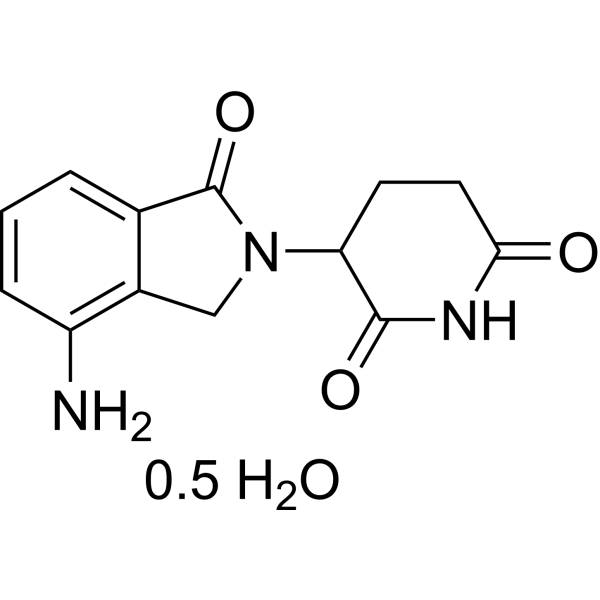
-
- HY-A0003A
-
|
CC-5013 hydrochloride
|
Ligands for E3 Ligase
Molecular Glues
|
Inflammation/Immunology
Cancer
|
|
Lenalidomide hydrochloride (CC-5013 hydrochloride), a derivative of Thalidomide, acts as molecular glue. Lenalidomide hydrochloride is an orally active immunomodulator. Lenalidomide hydrochloride (CC-5013 hydrochloride) is a ligand of ubiquitin E3 ligase cereblon (CRBN), and it causes selective ubiquitination and degradation of two lymphoid transcription factors, IKZF1 and IKZF3, by the CRBN-CRL4 ubiquitin ligase. Lenalidomide hydrochloride (CC-5013 hydrochloride) specifically inhibits growth of mature B-cell lymphomas, including multiple myeloma, and induces IL-2 release from T cells .
|
-
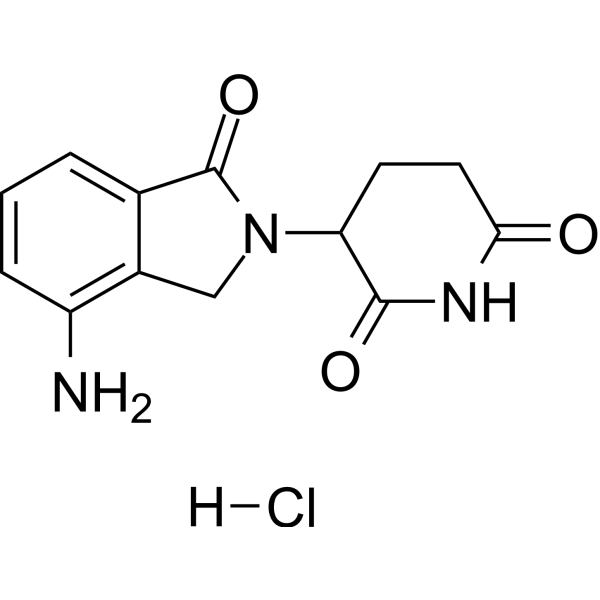
-
- HY-A0003S
-
|
CC-5013-d5
|
Isotope-Labeled Compounds
Ligands for E3 Ligase
Molecular Glues
Apoptosis
|
Inflammation/Immunology
Cancer
|
|
Lenalidomide-d5 is deuterium labeled Lenalidomide. Lenalidomide (CC-5013), a derivative of Thalidomide, acts as molecular glue. Lenalidomide is an orally active immunomodulator. Lenalidomide (CC-5013) is a ligand of ubiquitin E3 ligase cereblon (CRBN), and it causes selective ubiquitination and degradation of two lymphoid transcription factors, IKZF1 and IKZF3, by the CRBN-CRL4 ubiquitin ligase. Lenalidomide (CC-5013) specifically inhibits growth of mature B-cell lymphomas, including multiple myeloma, and induces IL-2 release from T cells[1][2].
|
-

-
- HY-103636
-
|
|
Sirtuin
PROTACs
|
Cancer
|
|
PROTAC Sirt2 Degrader-1 is a SirReal-based PROTAC, acts as a Sirt2 degrader, composed of a highly potent and isotype-selective Sirt2 inhibitor, a linker, and a bona fide Cereblon ligand for E3 ubiquitin ligase. PROTAC Sirt2 Degrader-1 shows an IC50 of 0.25 μM for Sirt2, with no effect on Sirt1/Sirt3 (IC50s>100 μM) .
|
-
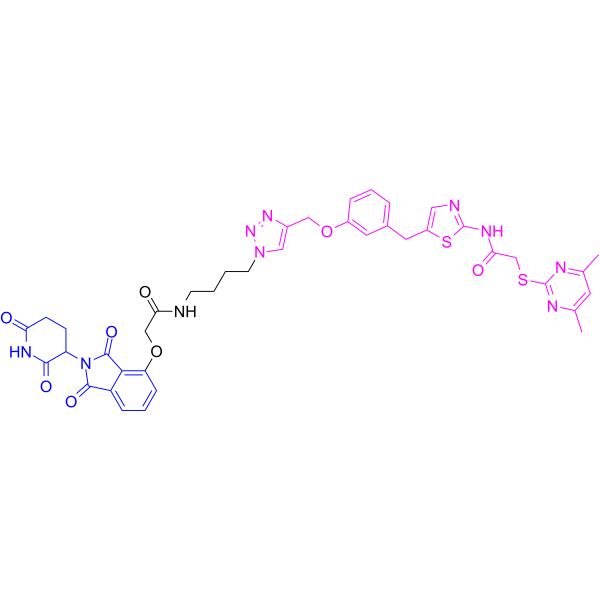
-
- HY-130683
-
|
|
E3 Ligase Ligand-Linker Conjugates
|
Cancer
|
|
Lenalidomide-propargyl-C2-NH2 hydrochloride incorporates a cereblon (CRBN) ligand for the E3 ubiquitin ligase, and a linker. Lenalidomide-propargyl-C2-NH2 hydrochloride can be used to design the PROTAC MD-224 (HY-114312) . Lenalidomide-propargyl-C2-NH2 (hydrochloride) is a click chemistry reagent, it contains an Alkyne group and can undergo copper-catalyzed azide-alkyne cycloaddition (CuAAc) with molecules containing Azide groups.
|
-
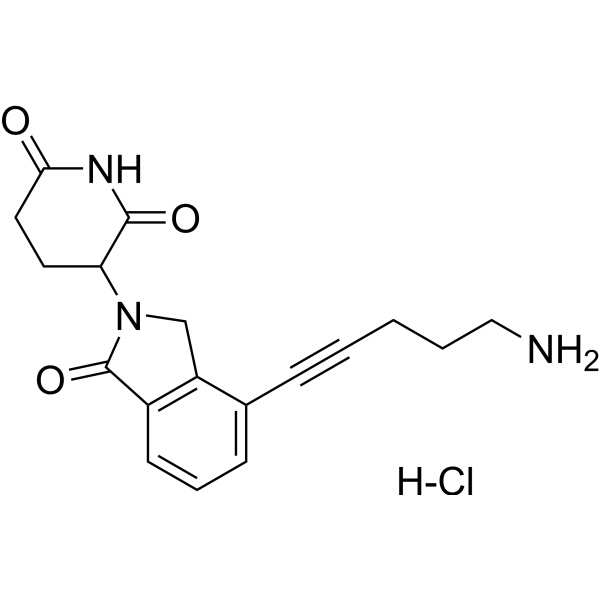
-
- HY-130682
-
|
|
E3 Ligase Ligand-Linker Conjugates
|
Cancer
|
|
Lenalidomide-propargyl-C2-amido-Ph-NH2 hydrochloride incorporates a cereblon (CRBN) ligand for the E3 ubiquitin ligase and a linker. Lenalidomide-propargyl-C2-amido-Ph-NH2 hydrochloride can be used to design the PROTAC MD-224 (HY-114312) . Lenalidomide-propargyl-C2-amido-Ph-NH2 (hydrochloride) is a click chemistry reagent, it contains an Alkyne group and can undergo copper-catalyzed azide-alkyne cycloaddition (CuAAc) with molecules containing Azide groups.
|
-
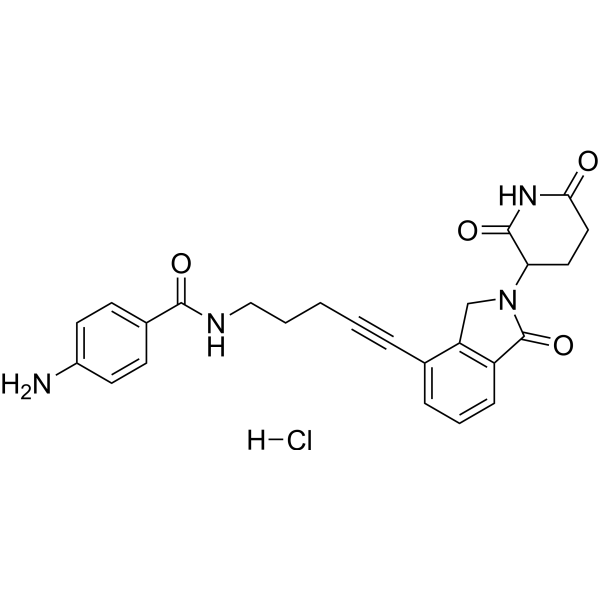
-
- HY-158105
-
|
|
PROTACs
BCL6
|
Cancer
|
|
ARV-393 is an orally active PROTAC that utilizes the ubiquitin-proteasome system to target the degradation of BCL6. ARV-393 consists of ligand conjugates targeting BCL6 and the E3 ligase cereblon, respectively. ARV-393 has DC50 and GI50 values of <1 nM in multiple cell lines of diffuse large B-cell lymphoma (DLBCL) and Burkitt lymphoma (BL). ARV-393 also demonstrated considerable tumor suppressor activity in tumor xenograft models. ARV-393 is being studied to inhibit non-Hodgkin lymphoma.
|
-
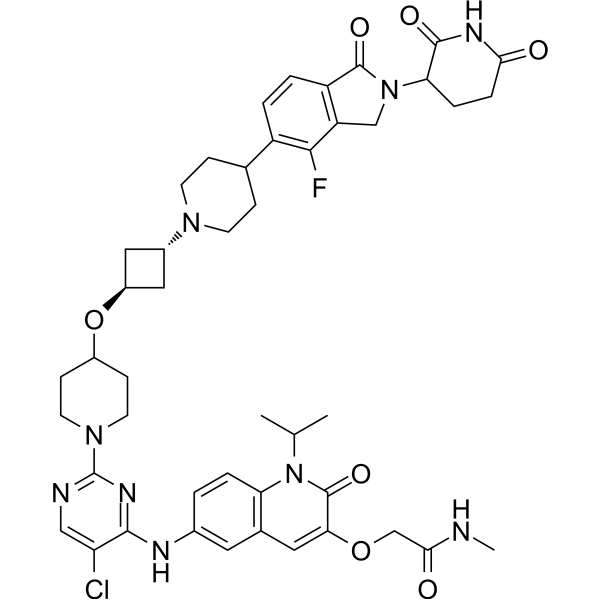
-
- HY-161131
-
|
|
Ligands for E3 Ligase
Apoptosis
Molecular Glues
|
Inflammation/Immunology
|
|
Lenalidomide 4'-alkyl-C3-azide (compound 4a) is a click chemical modified Lenalidomide (HY-A0003) that can be used to synthesize PROTACs. Lenalidomide is an orally active immunomodulator and a ligand for the ubiquitin E3 ligase cereblon (CRBN). Lenalidomide 4'-alkyl-C3-azide contains an Azide group and can undergo copper-catalyzed azide-alkyne cycloaddition reaction (CuAAc) with molecules containing Alkyne groups. Strain-promoted alkyne-azide cycloaddition reactions (SPAAC) can also occur with molecules containing DBCO or BCN groups .
|
-
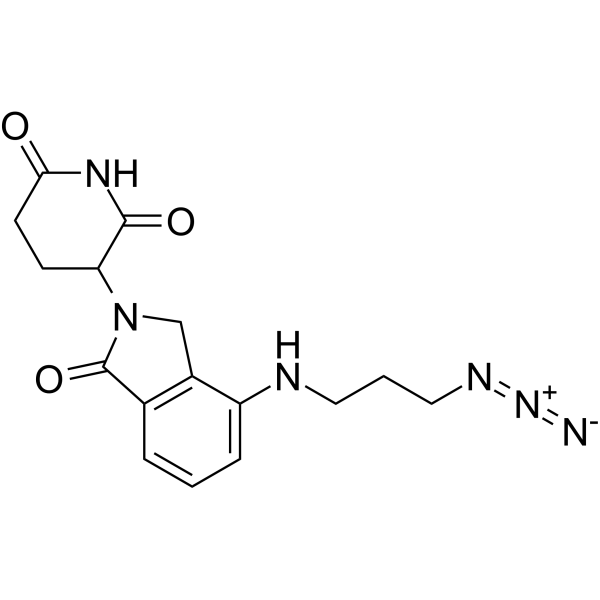
-
- HY-129602
-
SD-36
5 Publications Verification
|
PROTACs
STAT
Apoptosis
|
Cancer
|
|
SD-36 is a potent and efficacious STAT3 PROTAC degrader (Kd=~50 nM), and demonstrates high selectivity over other STAT members. SD-36 also effectively degrades mutated STAT3 proteins in cells and suppresses the transcriptional activity of STAT3 (IC50=10 nM). SD-36 exerts robust anti-tumor activity, and achieves complete and long-lasting tumor regression in mouse tumor models. SD-36 is composed of the STAT3 inhibitor SI-109, a linker, and an analog of Cereblon ligand Lenalidomide for E3 ubiquitin ligase . SD-36 is a click chemistry reagent, it contains an Alkyne group and can undergo copper-catalyzed azide-alkyne cycloaddition (CuAAc) with molecules containing Azide groups.
|
-
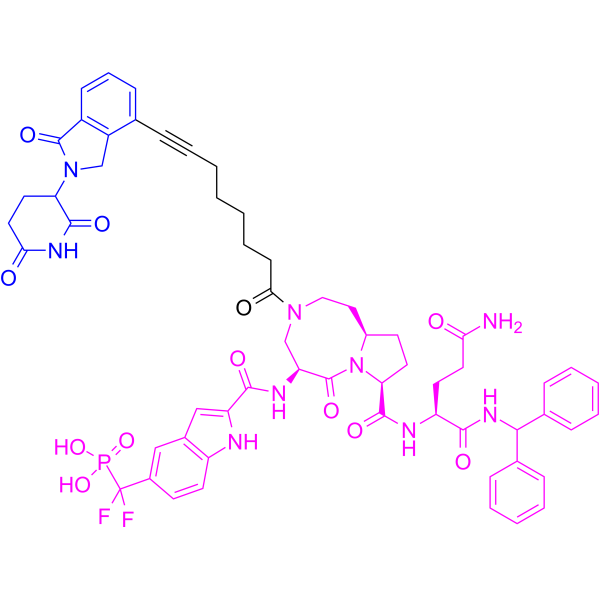
-
-
HY-L128
-
|
|
88 compounds
|
|
Proteolysis-targeting chimera (PROTAC) has been developed to be a useful technology for targeted protein degradation. PROTACs consist of a ligand for E3 ligase (E3 ligase binder), a linker and a ligand (mostly small-molecule inhibitor) for protein of interest(target binder). Upon binding to the target protein, the PROTACs can recruit E3 for target protein ubiquitination, which is subjected to proteasome-mediated degradation.
Although there are more than 600 E3 ubiquitin ligases, only several with small molecule ligands have been used for designing PROTACs, including Skp1-Cullin-F box complex containing Hrt1 (SCF), Von Hippel-Lindau tumor suppressor (VHL), Cereblon (CRBN), inhibitor of apoptosis proteins (IAPs), and mouse double minute 2 homolog (MDM2).
MCE carefully prepared a unique collection of 88 ligands for E3 ligase, which have been reported to be used in PROTAC design. MCE E3 ligase ligand library is a useful tool for PROTAC development.
|
| Cat. No. |
Product Name |
Chemical Structure |
-
- HY-14658S
-
|
|
|
Thalidomide-d4 is a deuterium labeled Thalidomide. Thalidomide inhibits cereblon (CRBN), a part of the cullin-4 E3 ubiquitin ligase complex CUL4-RBX1-DDB1, with a Kd of ~250 nM, and has immunomodulatory, anti-inflammatory and anti-angiogenic cancer properties[1][2].
|
-

-
- HY-A0003S
-
|
|
|
Lenalidomide-d5 is deuterium labeled Lenalidomide. Lenalidomide (CC-5013), a derivative of Thalidomide, acts as molecular glue. Lenalidomide is an orally active immunomodulator. Lenalidomide (CC-5013) is a ligand of ubiquitin E3 ligase cereblon (CRBN), and it causes selective ubiquitination and degradation of two lymphoid transcription factors, IKZF1 and IKZF3, by the CRBN-CRL4 ubiquitin ligase. Lenalidomide (CC-5013) specifically inhibits growth of mature B-cell lymphomas, including multiple myeloma, and induces IL-2 release from T cells[1][2].
|
-

| Cat. No. |
Product Name |
|
Classification |
-
- HY-157510
-
|
|
|
Azide
|
|
Thalidomide-O-C3-azide is a click chemistry modification of the cereblon (CRBN) inhibitor Thalidomide (HY-14658). Thalidomide-O-C3-azide contains an azide group and can undergo copper-catalyzed azide-alkyne cycloaddition reaction (CuAAc) with molecules containing alkyne groups. Thalidomide-O-C3-azide can be used as a ligand of E3 ubiquitin ligase and Linker conjugates (E3 Ligase Ligand-Linker Conjugates) for the synthesis of PROTACs .
|
-
- HY-157511
-
|
|
|
Azide
|
|
Thalidomide-O-C5-azide is a click chemistry modification of the cereblon (CRBN) inhibitor Thalidomide (HY-14658). Thalidomide-O-C5-azide contains an azide group and can undergo copper-catalyzed azide-alkyne cycloaddition reaction (CuAAc) with molecules containing alkyne groups. Thalidomide-O-C5-azide can be used as a ligand of E3 ubiquitin ligase and Linker conjugates (E3 Ligase Ligand-Linker Conjugates) for the synthesis of PROTACs .
|
-
- HY-157515
-
|
|
|
Azide
|
|
Thalidomide 4'-ether-PEG2-azide is a click chemistry modified cereblon (CRBN) inhibitor Thalidomide (HY-14658). Thalidomide 4'-ether-PEG2-azide contains an azide group and can undergo copper-catalyzed azide-alkyne cycloaddition reaction (CuAAc) with molecules containing alkynyl groups. Thalidomide 4'-ether-PEG2-azide can be used as a ligand of E3 ubiquitin ligase and Linker conjugates (E3 Ligase Ligand-Linker Conjugates) for the synthesis of PROTACs .
|
-
- HY-161131
-
|
|
|
Azide
|
|
Lenalidomide 4'-alkyl-C3-azide (compound 4a) is a click chemical modified Lenalidomide (HY-A0003) that can be used to synthesize PROTACs. Lenalidomide is an orally active immunomodulator and a ligand for the ubiquitin E3 ligase cereblon (CRBN). Lenalidomide 4'-alkyl-C3-azide contains an Azide group and can undergo copper-catalyzed azide-alkyne cycloaddition reaction (CuAAc) with molecules containing Alkyne groups. Strain-promoted alkyne-azide cycloaddition reactions (SPAAC) can also occur with molecules containing DBCO or BCN groups .
|
Your information is safe with us. * Required Fields.
Inquiry Information
- Product Name:
- Cat. No.:
- Quantity:
- MCE Japan Authorized Agent:













































